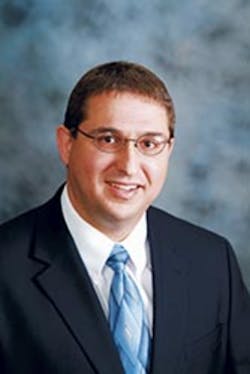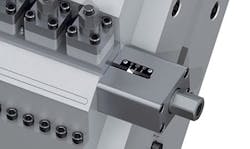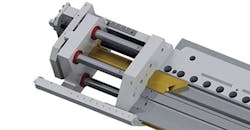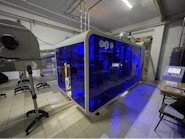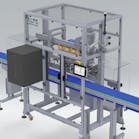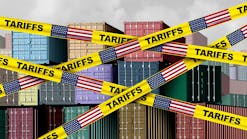Nordson Extrusion Dies Industries (EDI) has unveiled a new extrusion die technology for producing high-quality sheet.
Sam Iuliano, senior technical manager for Nordson, recently discussed the company's new UltraTune restrictor bar with single-point adjustment that is designed to improve the quality of sheet, reduce extruder downtime and increase efficiency compared with traditional restrictor bars. Iuliano, who is the lead inventor, talked about the technology at the Extrusion 2017 conference in Charlotte, N.C., held Oct. 18-20 and sponsored by Plastics Technology and Gardner Business Media Inc.
Nordson filed for a patent in May, and Iuliano said the extrusion conference was the first opportunity he had to discuss the technology at a trade conference.
A restrictor bar, or R-bar, normally is used when producing sheet thicker than 90 mils. It helps to smooth out thick areas of the sheet and push the melt toward the edges of the die, where it normally is thinnest.
If producing sheet thinner than 90 mils, a restrictor bar is generally not needed because adjustments to the flexible lip on the die and to the die's temperature zones can ensure uniform sheet thickness, he said.
"Tuning devices — the restrictor bar, the flexible lip, even the die body heat temperature zones, are all used to kind of refine that distribution and get it more and more perfect, more uniform," Iuliano said. "There are two things that are unique about the UltraTune system: the single-point adjustment mechanism and the pre-land distributor in the flow surface of the restrictor bar."
A normal restrictor bar is tightened down by adjusting studs on the bar. If an extruder operator wants to make the sheet thinner in the middle, he or she can tighten the studs in the middle of the bar. For more flow in the middle of the sheet, those same studs can be loosened.
"The conventional adjusters on the conventional restrictor bar, they were on roughly 2¾-inch center lines. If you had a 100-inch die, you might have 36 adjustments to make to contort that restrictor bar," Iuliano said. "That takes time and operator experience."
By comparison, the UltraTune restrictor bar has a single-point adjustment mechanism. In addition, Nordson has incorporated a pre-land distributor into the restrictor bar. The pre-land is a raised surface in the center of the bar. It gradually increases to a maximum height in the center. By lowering the bar using the adjustment mechanism, an operator can force more material to flow to the edges of the sheet, which generally are thinner than the center. By raising the UltraTune restrictor bar, an operator can allow more material to flow to the center and less to the edges.
The adjuster, marked with a scale, raises and lowers the restrictor bar. By noting the setting on the scale, an operator can quickly and accurately change a setting for a new production run and then quickly reset the bar to return to the previous production specifications.
"The old way of tuning an R-bar is to change the clearance," Iuliano said. "Then you have to contort the restrictor bar. You have to bend it, twist it. That can lead to part breakage. Having this distributor built into the bar, simply by moving it straight up and straight down, you force either more flow to the edges or less flow to the edges just by changing the clearance uniformly."Iuliano said improper adjustments to the conventional restrictor bar require extra tuning iterations and can damage the bar or studs, force a die out of calibration and lead to a product that is out of specification.
"The single adjusting point is obviously a time-saver," he said. "This prevents erratic, asymmetrical or illogical adjustments from being made."
As experienced extruder operators retire, Nordson predicts an increasing demand for the UltraTune product.
"There is a trend toward more turnover in the industry," Iuliano said. "This system allows you to make very logical adjustments, benefitting tenured operators as well as those recently hired."
UltraTune can be used with any brand extruder and in any application in which a customer currently is using a restrictor bar. However, it does require the purchase of a special Nordson die.
"It is not retrofittable to existing dies," Iuliano said. "The reason is, we combined two features that are historically separate chambers. Normally, the pre-land is in the die and downstream is the restrictor bar. Now, we put the pre-land distributor onto the flow face of the restrictor bar."
Having two pre-lands, one in the die and one in the restrictor bar, would be incompatible, Iuliano said.
The UltraTune restrictor bar and a new die will be more expensive than a traditional restrictor bar, but Nordson believes the long-term cost of ownership will be lower.
"There is a small premium for this feature, but it more than pays for itself in increased productivity and reduced scrap," Iuliano said.
UltraTune is available with an optional dual-deckle system that can reduce residence time, improve purging and eliminate the need to clamp the restrictor bar down on the ends behind the deckle.
Deckling reduces the width of a sheet without having to change dies. It involves adjustments to a die that dam the lips to create narrower sheet than the die normally produces. It cuts down on waste by reducing the amount of material that needs to be trimmed from sheet edges. However, deckling can result in the creation of edge beads, or thicker edges. One way to reduce edge beads is to clamp down on restrictor bar studs on the outside edges. However, that would eliminate many of the benefits of the UltraTune bar, which normally doesn't require manual stud adjustments or bending. The dual-deckle system reduces the edge flow through the restrictor bar without making stud adjustments, the company said.
UltraTune also can work with Nordson's SmartGap adjustment system, introduced in 2015, which is a lip-and-land positioning system for sheet dies that uses a single-point adjustment mechanism. The mechanism changes the lip gap while simultaneously modifying the length of the lip land to provide the most appropriate conditions for the newly adjusted thickness as the sheet exits the die.
The SmartGap system results in quick changes to sheet thickness. It eliminates extended shutdowns that are sometimes required for changes in lip components, reducing changeover time from hours to a few minutes and allowing multiple product changes per day.
Bruce Geiselman, senior staff reporter
Contact:
Nordson Extrusion Dies Industries LLCChippewa Falls, Wis., 715-726-1201, www.nordsonpolymerprocessing.com
Bruce Geiselman | Senior Staff Reporter
Senior Staff Reporter Bruce Geiselman covers extrusion, blow molding, additive manufacturing, automation and end markets including automotive and packaging. He also writes features, including In Other Words and Problem Solved, for Plastics Machinery & Manufacturing, Plastics Recycling and The Journal of Blow Molding. He has extensive experience in daily and magazine journalism.

